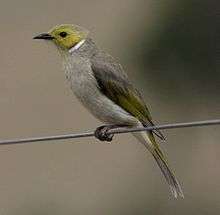White-plumed honeyeater
| White-plumed honeyeater | |
|---|---|
 | |
| At Sundown National Park, Queensland, Australia | |
| Scientific classification | |
| Kingdom: | Animalia |
| Phylum: | Chordata |
| Class: | Aves |
| Order: | Passeriformes |
| Family: | Meliphagidae |
| Genus: | Ptilotula |
| Species: | P. penicillata |
| Binomial name | |
| Ptilotula penicillata (Gould, 1837) | |
| Synonyms | |
|
Lichenostomus penicillatus | |
The white-plumed honeyeater (Ptilotula penicillata) is a bird native to Australia. It is yellow above and paler beneath, with a black and white line on the sides of its neck. The white neck band of a white-plumed honeyeater is its most prominent feature, the rest of the feathers being shades of green and buff. Juveniles have a pinkish orange beak that darkens to black in adults. Honeyeaters feed on nectar and insects and their nest is a small cup nest in a tree. The size of an average white-plumed honeyeater is approximately 19 cm.
White-plumed honeyeaters are common around water and are often seen in backyards and suburbs with vegetation cover.[2]
The white-plumed honeyeater was previously placed in the genus Lichenostomus but was moved to Ptilotula after a molecular phylogenetic analysis published in 2011 showed that the original genus was polyphyletic.[3][4]
- The cup nest
- Nest with two eggs
References
- ↑ BirdLife International (2012). "Lichenostomus penicillatus". IUCN Red List of Threatened Species. Version 2013.2. International Union for Conservation of Nature. Retrieved 26 November 2013.
- ↑ http://www.birdsinbackyards.net/species/Lichenostomus-penicillatus
- ↑ Nyári, Á.S.; Joseph, L. (2011). "Systematic dismantlement of Lichenostomus improves the basis for understanding relationships within the honeyeaters (Meliphagidae) and historical development of Australo–Papuan bird communities". Emu. 111: 202–211. doi:10.1071/mu10047.
- ↑ Gill, Frank; Donsker, David (eds.). "Honeyeaters". World Bird List Version 6.1. International Ornithologists' Union. Retrieved 28 January 2016.
| Wikimedia Commons has media related to Lichenostomus penicillatus. |
